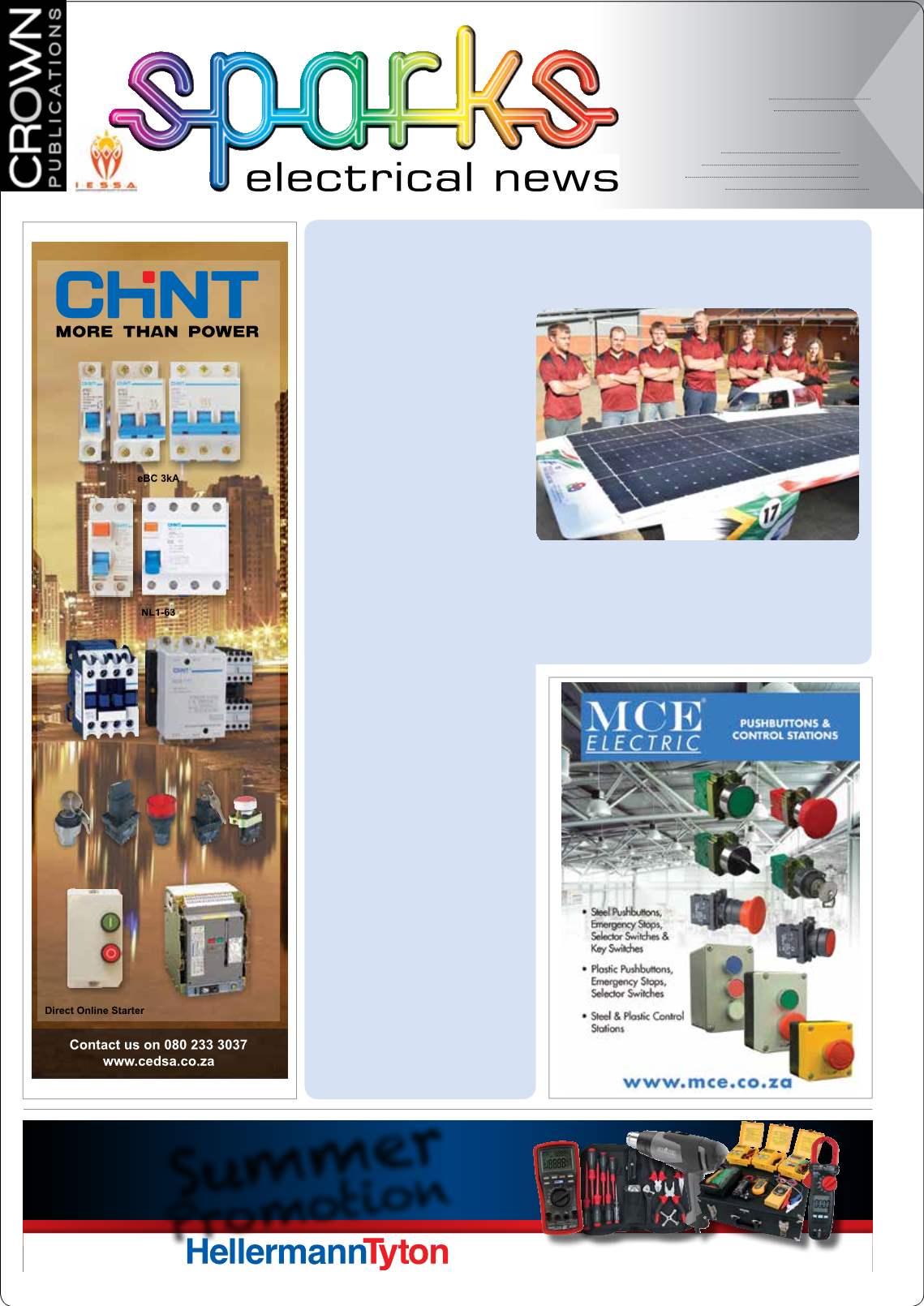

IN THIS ISSUE
October 2015
www.crown.co.za• Energy measurement and supply
• Motors and motor control centres
18
19-21
FEATURES
• Contractors’ corner
• Buyers’ guide
• Lighting
• People on the move
REGULARS
1-13, 16-17
14-15
22-27
28
27756/jhafrika Valid from 14 September to 04 December 2015 Visit www.hellermantyton.co.za for promotion details Summer Promotion Instruments and Tools Brought to you by Now on!ENGINEERING students at the North-West University
(NWU) will rub shoulders with the big names in solar
energy when they take part in the BridgestoneWorld
Solar Challenge in Australia from18 to 26 October.
Dubbed the‘Dakar of solar rallies’because of the
harsh conditions and the searing heat of the
Australian outback, the competition starts in Darwin
in northern Australia, and 45 vehicles from25 coun-
tries will be racingmore than 3 000 kmacross the
country to Adelaide.
Following the NWU’s successes in the local Sasol
Solar challenges in 2012 and 2014, the teamhas
improved on the original design, harnessing new
technology tomake the new vehicle faster, lighter,
more effective and stronger.
Prof Albert Helberg, team leader, says:“We will be
competing against the top universities in the solar
energy fields andwant to prove that we can align
ourselves with their expertise.”
There are three classes in the competition and, the
NWU teamwill participate in the aptly named‘Chal-
lenger’class. According to Helberg“it’s all about the
vehicle’s speed and efficiency”.
“We should cover the distance in seven days but we
are aiming to do it in five days,”says Helberg.“Usually
only one-third of all participants complete the race in
the allotted time.”
When comparing the NWU’s first solar car – the
2012 Batmobile – with the new one, the biggest dif-
ference is the weight. The Batmobile weighedmore
than 300 kg and the new Sirius X25 although bigger
than its predecessor, weighs amere 185 kg.
The drive system changed from two front-wheel
drivemotors in 2012 to a single rear-wheel drivemo-
tor. The battery pack is technologically better and also
weighs less. The aerodynamics of the cockpit profile
were based on the latest sailplane technology and the
vehicle’s control systems have brand-new technology
that allow for adjustments to the vehicle’s electric
current during changing weather conditions while it
is operational.
Six squaremetres of solar panels are affixed to the
top of the vehicle and the cockpit profile is manufac-
turedwith carbon fibre and resin, which is three times
stronger than steel, but obviouslymuch lighter.
The vehiclemust be able to travel at least 500 km
per day to finish the race within the allotted time.
While the speed of the Sirius X25 is limited to 120 km
per hour, according to the team’s research, themost
effective speed is around 75 kmper hour.
Objective
“Our biggest dreamwill come true if we can finish the
race and, be the first ever team fromAfrica to cross
the finishing line,”he says, adding that this will put the
team“in the record books”.“This is a learning project,
and part of our long-termvision. This experience
will enable us to aim for a podiumposition in 2017.
He says this race is not“merely another race that will
cost millions of rand for finishing-line glory”– it has
an impact on ordinary citizens. Replacing traditional
household electrical appliances with appliances that
work amere 5%more effectively, would save energy
equal to over half the electricity that the Koeberg
power station generates.“In building this vehicle, we
are proving that all personal energy needs can be
Students’ solar car to take on the
world’s best in Australian challenge
Engineering students at the North-West University who will take part in the Bridgestone
World Solar Challenge in Australia from 18 to 26 October, seen here with their solar car, are:
Ryno du Preez; Raynard du Preez; Estienne Janse van Rensburg; Arno de Beer (technical
manager); Prof Albert Helberg (team leader); Waks van Tonder; and Bronwyn Payne.
met by renewable energy, even transport needs ... but
because these contemporary components are not yet
mass produced, not everyone can afford them. This is
an effort to turn this around,”says Helberg.
Enquiries:
www.nwu.ac.za/solarcar NC1 NC2 PUSH BUTTONS NA1














